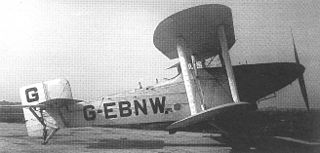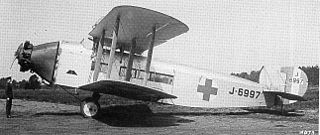
The Avro 691 Lancastrian was a British and Canadian passenger and mail transport aircraft of the 1940s and 1950s developed from the Avro Lancaster heavy bomber. The Lancastrian was basically a modified Lancaster bomber without armour or armament and with the gun turrets replaced by streamlined metal fairings, including a new nose section. The initial batch was converted directly from Lancasters; later batches were new builds.
The Hawker Hedgehog was a three-seat reconnaissance biplane, to be used for naval scouting, produced to meet Air Ministry Specification 37/22.

The Avro Andover was a 1920s British military transport aircraft built by Avro for the Royal Air Force. Four aircraft were built, in two versions. Three aircraft, the Type 561, were used as flying ambulances. The sole example of the Type 563 was used as a 12-seater transport.

The Avro 549 Aldershot was a British single-engined heavy bomber aircraft built by Avro.

The Avro 555 Bison was a British single-engined fleet spotter/reconnaissance aircraft built by Avro.

The Foster Wikner Wicko was a 1930s British two-seat cabin monoplane built by the Foster Wikner Aircraft Company Limited at Southampton Airport, Hampshire.

The Avro 566 Avenger was a prototype British fighter of the 1920s, designed and built by Avro. It was a single-seat, single-engine biplane of wood and fabric construction. Although it was a streamlined and advanced design, it never entered production.

The Central Centaur IIA, a.k.a. Central C.F.2a, was a British civil six-passenger joyriding biplane aircraft produced by Central Aircraft Company Limited of London.

The de Havilland DH.29 Doncaster was a British long-range high-wing monoplane of the 1920s built by de Havilland.

The Avro Type 584 Avocet was a British single-engined naval fighter prototype, designed and built by Avro. While the Avocet was not built in numbers, one of the prototypes was used as a seaplane trainer for the Royal Air Force's (RAF) High Speed Flight.

The Avro Cadet is a single-engined British biplane trainer designed and built by Avro in the 1930s as a smaller development of the Avro Tutor for civil use.

The Avro Club Cadet was a 1930s single-engined British biplane trainer aircraft, designed and built by Avro as a development of the earlier Cadet. It was planned for private and club use and, unlike the Cadet, was fitted with folding wings.

The Avro 571 Buffalo was a prototype British carrier-based torpedo bomber biplane, designed and built by Avro in the 1920s. It was not selected for service, the Blackburn Ripon being ordered instead.

The Avro 604 Antelope was a British light bomber which was designed and built in the late 1920s to meet a requirement for a light bomber to equip the Royal Air Force, competing against the Hawker Hart and the Fairey Fox II. It was unsuccessful, the Hart being preferred.

The Avro 627 Mailplane was a British biplane developed in 1931 by Avro from the Avro Antelope bomber as a mail plane for use in Canada. Only one was built which ended up being used as a test bed.

The Avro 701 Athena is a British advanced trainer aircraft built by Avro in the late 1940s. It was designed to replace the North American Harvard in the Royal Air Force, but was bought only in small numbers, the competing Boulton Paul Balliol being preferred.

The Avro Type E, Type 500, and Type 502 made up a family of early British military aircraft, regarded by Alliott Verdon Roe as his firm's first truly successful design. It was a forerunner of the Avro 504, one of the outstanding aircraft of the First World War.

The Bristol Ten-seater and Bristol Brandon were British single-engine biplane transport aircraft built by the Bristol Aeroplane Company in the early 1920s. Only three were built, two of which were used as civil transports and one of which served with the Royal Air Force.

The Avro Type 557 Ava was a British twin-engined biplane torpedo bomber of the 1920s. It was developed by Avro to meet a requirement for a heavy torpedo bomber for the Royal Air Force but was unsuccessful, only two prototypes being built.

The Avro 533 Manchester was a First World War-era twin-engine biplane photo-reconnaissance and bomber aircraft designed and manufactured by Avro.




















